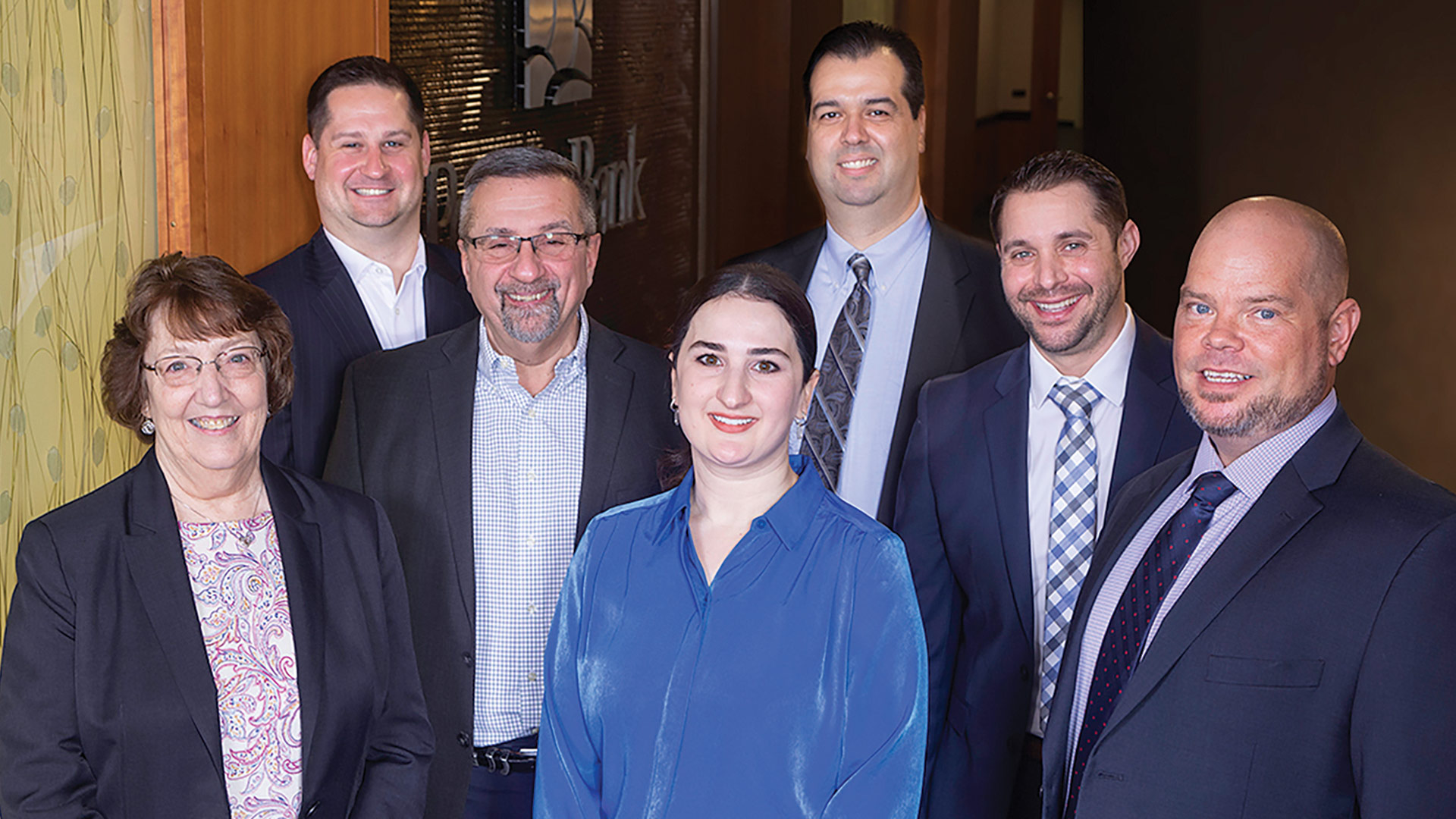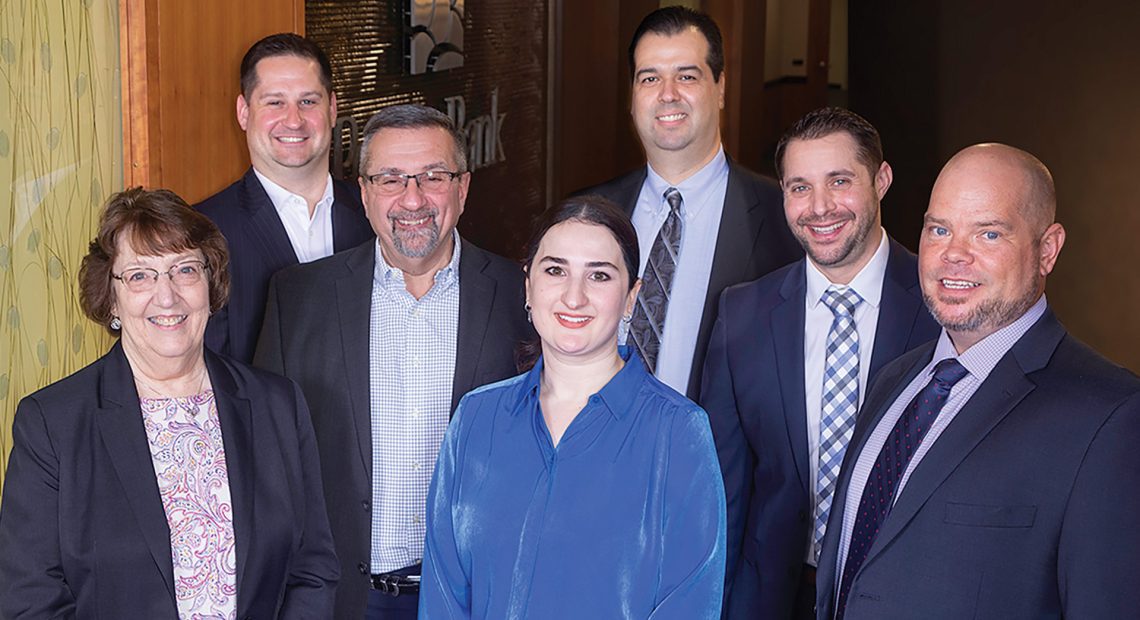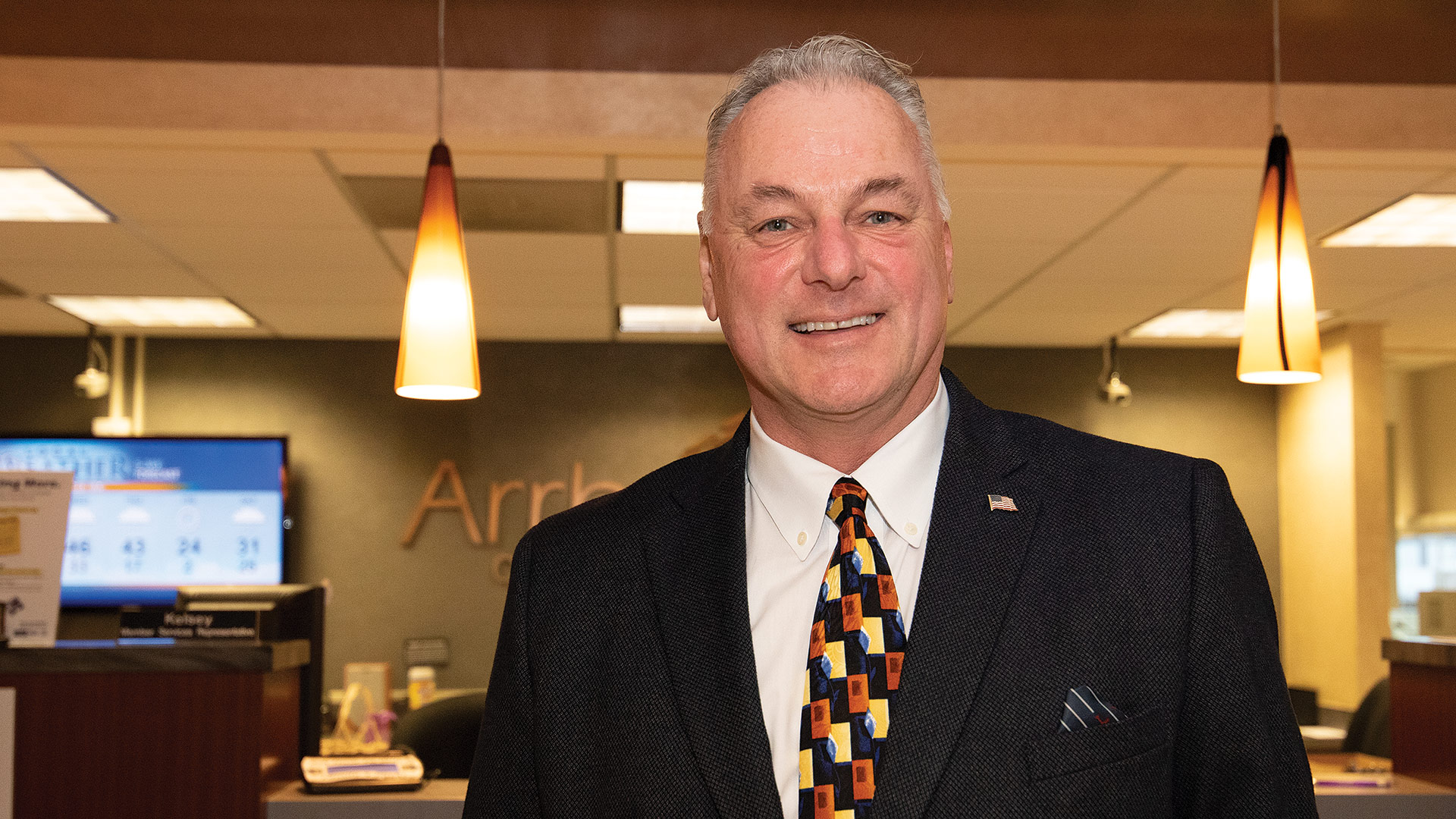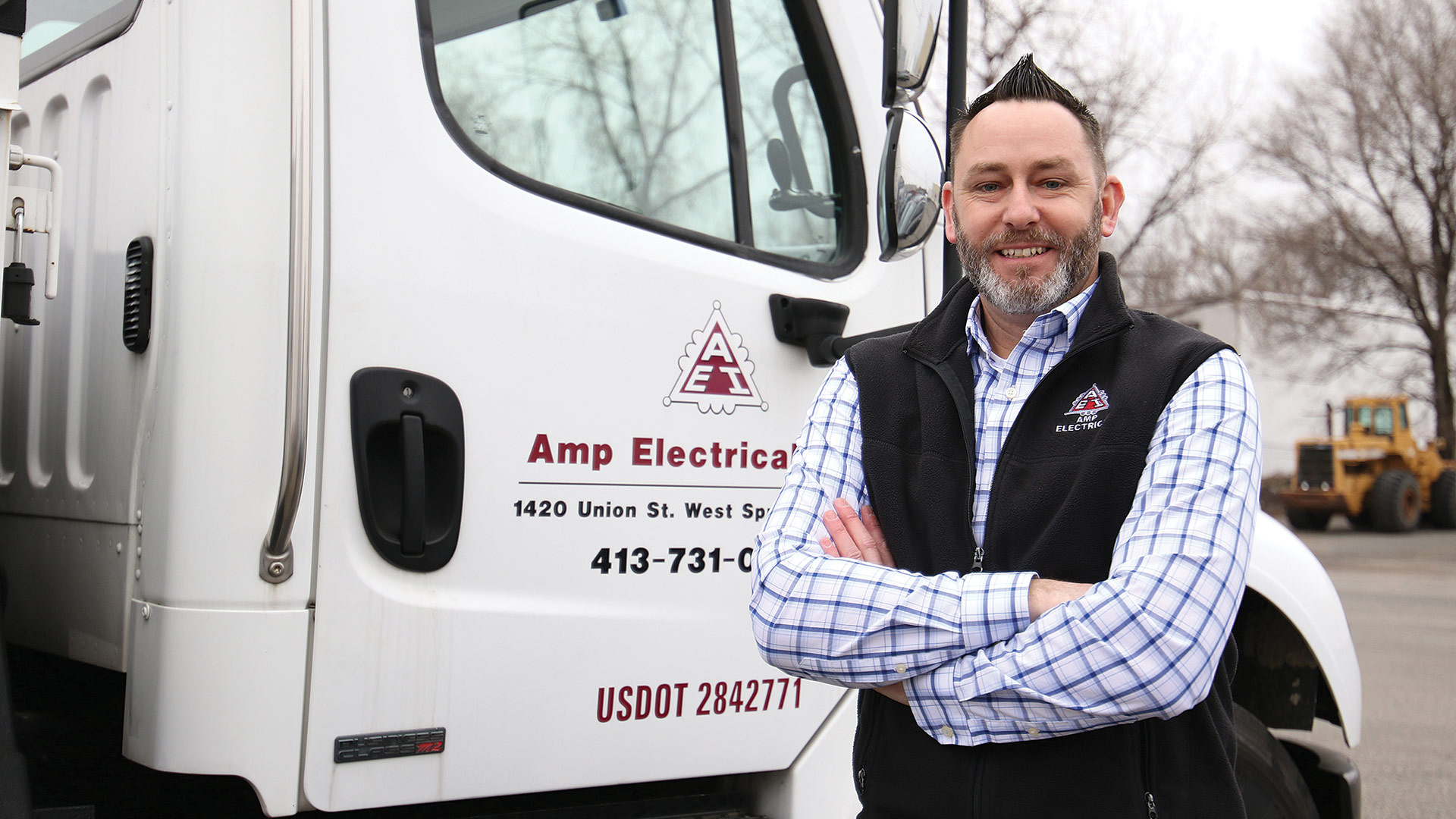Matters of Interest

James Sherbo (third from left), senior vice president of Consumer Lending at PeoplesBank, with his team of mortgage consultants.
Mike Ostrowski remembers signing for his first mortgage.
The year was 1982. The 30-year adjustable rate was … wait for it … 16.37%.
“You could put a house on a credit card and beat that rate,” said Ostrowski, president and CEO of Arrha Credit Union. From that historical perspective, he noted, today’s rates, typically between 5% and 6%, don’t seem so onerous.
“We don’t make the market. We would like to see a nice, steady rate that does not fluctuate and move, but the fact of the matter is, even if the rates are hovering around 5% or 6% right now, that’s still a great rate,” he went on. “Did you catch the bottom of the market at 3%? Maybe some people did, and that’s great, but 6% isn’t ridiculous. It needs to be put in perspective. People forget.”
That they do, said Kevin O’Connor, executive vice president of Westfield Bank. “People were really used to rates of 3% for 30 years fixed,” he said, though he was quick to note that doubling that rate does alter the affordability of some houses when shopping in today’s market, and he’s sensitive to that reality. Still, “people are surprised right now, but 15 years ago, 8% to 9% was common, so a lot of us still view 5% as a good rate.”
Mike Ostrowski
“The whole goal in all of this is to cool down the overheated market, try to slow it down. If the Fed doesn’t take any action, you could be mired in inflation for a long time. And that’s certainly not to anyone’s benefit.”
James Sherbo, senior vice president of Consumer Lending at PeoplesBank, had similar thoughts, noting that, while 5% to 6% mortgage interest rates are historically low, they don’t seem low when people have been accustomed to a long stretch of much lower rates. And he understands why those interest rates, which are not directly tied to the Federal Reserve’s actions but tend to follow that pattern, are rising.
“Overall, it’s to slow inflation down, and part of that formula is the housing market,” Sherbo explained. “The thought is that, as rates increase, it will slow down the activity we’ve seen in the market the past couple of years.”
That activity has included an unprecedented swelling of home prices, driven by the laws of supply and demand — the former dragging way behind the latter in the wake of the pandemic and building-supply shortages.
“The whole goal in all of this is to cool down the overheated market, try to slow it down,” Ostrowski said. “If the Fed doesn’t take any action, you could be mired in inflation for a long time. And that’s certainly not to anyone’s benefit.”
O’Connor noted that the Fed’s recent moves to boost the prime lending rate, which has led to increases in other areas of the rate environment, including mortgages, have required banks to balance that reality with the needs of borrowers.
“In our case, how do we best position that rate for what the bank needs as well as what is good for customers and the community as a whole?” he said. “When rates were rising, we were probably looking at it daily. That’s not typical; we try to set rates as best we can for a week, so customers and Realtors are looking at something they can rely on, so they can plan.”
That daily whiplash has stabilized somewhat, to where the bank may alter the rate an eighth of a point during any given week, he added.
For this issue’s focus on banking and financial services, BusinessWest talked with several area industry leaders about why mortgage interest rates have been so volatile lately, and how they’re addressing the needs and concerns of borrowers.
Bottom-line Impact
Craig Boivin, vice president of Marketing at UMassFive College Federal Credit Union, understands the historical picture of mortgage rates, but also sees consumers’ side: that buying a house in 2022 will cost them significantly more on their monthly bill than a house bought for the same price in 2021.
“Compound that with the fact that rents are higher, and it puts people in a position of ‘should I bid on houses when the values haven’t come down yet, or pony up another year of rent, which has increased a couple hundred dollars as well?’
“We’ve had a lot of conversations internally about how to help people get into homes,” Boivin went on. “Home ownership is one way people move into a higher economic class. We also know how homeowners benefit from values going up, as they can tap into home equity. So, how do we help people navigate this crazy environment?”
Craig Boivan
“We often tell folks who are getting into the homebuying game, especially people entering this crazy world for the first time, ‘take the workshop. We’ll show you different rate options, who you’ll be working with, finding your agent, all those things. Just talk to us.”
One way is by offering a wide range of products and matching borrowers to the right ones. For instance, UMassFive’s adjustable-rate mortgage product, which offers lower fixed rates over the first several years, followed by variable rates later on, can be a solid option for certain people.
“Those loans got a bad rap in the 2000s leading up to the housing burst because there was a lot less strict criteria around granting mortgages; some financial institutions were giving loans to people who couldn’t afford them,” he explained, which led to financial pain when a loan’s rate shot up.
But some customers are ideal fits for these types of loans, he said, such as first-time homebuyers who are already planning to move to their next home early in the loan, or medical residents who move around often, or professors who don’t have tenure and expect their current job to be transitory.
“One of the main reasons we can offer such a wide range of products is the way we set up our mortgage department,” Boivin said, noting that UMassFive invested in a credit-union service organization, or CUSO, called Member Advantage Mortgage, back around 2008. CUSOs allow a number of credit unions to create scale by pooling their resources on a particular program — in this case mortgages — which allows them to craft unique products for their members while weathering the kind of economic volatility that can upend business.
Lauren Duffy, chief operating officer at UMassFive, is executive chair of the Member Advantage Mortgage board of directors, “so we have direct oversight and a lot of influence,” Boivin noted.
O’Connor said Westfield Bank helps potential borrowers through its pre-qualification program, called ‘lock and shop.’ “They leave here knowing what their level of affordability will be, and their payment, based on current market rates. Then they can go out there and do some shopping.”
The idea is to avoid situations where shoppers think they’ve found the perfect home, only to find it’s unaffordable later, based on current rates, he explained.
Kevin O’Connor
“We want to take the uncertainty off someone’s head and give them some stability. We try to work with people in that way in these unsettled times.”
“That’s certainly helpful. We want to take the uncertainty off someone’s head and give them some stability. We try to work with people in that way in these unsettled times. Certainly, as a community bank, we feel a strong obligation to the community to find security and peace of mind for customers through this process.”
Boivin said UMassFive likes to “lead with education,” which is the motivator behind its educational programs, like Home Buying 101.
“We often tell folks who are getting into the homebuying game, especially people entering this crazy world for the first time, ‘take the workshop. We’ll show you different rate options, who you’ll be working with, finding your agent, all those things. Just talk to us.’”
Dollars and Sense
While mortgage volume hasn’t gone down at most institutions, refinancing has understandably taken a hit.
“We saw lots of refinancing from 5% to 3%; these people are not going to give up their rate now for any reason,” O’Connor said. “But a home-equity line of credit is an alternative, so they can preserve their lower interest rate, and we’re seeing home-equity volumes back up. A line of credit is variable to prime, and people understand that, but for many people, it’s worth doing that rather than give up their fixed-rate mortgage.”
Ostrowski said there will always be some refinancing business “because there’s always a need for money. People always need to send their kids to college, and they always want to make improvements to their homes.”
On the mortgage-origination side, the first-time homebuyer segment is most affected by higher interest rates, Sherbo said, simply because they don’t have a home to sell in this inflated market.
“They have the double whammy of higher rates and higher prices at the same time, and they often don’t have the wherewithal to withstand a bidding war on a property. So we have to do our best and be as competitive as we can on our products and our rates. We historically have low loan fees compared to our competitors, and a strong relationship with the real-estate community here in our footprint. Over time, we’ve developed a very good reputation for getting things done.”
The good news is that higher rates, married with a slight easing of the supply-and-demand conundrum, may push prices down, “but I don’t think we’ve seen that happen quite yet,” Sherbo added. “I think things should at least start settling down a little bit. We’re not seeing the bidding wars as hot and heavy as we have in the past. In some areas, there are some signs things are cooling down a little bit, which will help prices stabilize.”
He emphasized the importance of a community bank’s role in guiding customers to good decisions. “We know the market, and we can make adjustments quickly. We’re very agile when we have to adjust and change our programs a bit. We have to be focused on being competitive on rates, and we want to give buyers options. As soon as you feel you’ll be in the market, come talk to us, get pre-qualified, and we can guide you through what your options are.”
Ostrowski hopes home prices ease as well, but new housing starts nationally remain slow, which is indicative of the still-high cost of building materials, among other factors. But considering the big picture, he doesn’t think current mortgage rates should stop potential buyers from jumping into the pool.
“Realtors care about making a sale as quickly as possible. I don’t blame them; that’s their job. So they’re going to take a more negative view on this,” he told BusinessWest. “I don’t look at it as negative. You have to deal with normal fluctuations in this business. It might be slightly more than normal right now, but I wouldn’t hesitate in buying in the current market.”
Joseph Bednar can be reached at [email protected]















